This small batch recipe for homemade fermented hot sauce is a wonderful way to use those fresh summer peppers from the garden or farmer’s market. If you have never fermented food before, this is a great recipe to start with as it’s easy and almost foolproof.
Make sure to also try my tropical fermented hot sauces: Pineapple Hot Sauce, Mango Hot Sauce and Passion Fruit Hot Sauce!

Table of Contents
- What’s the Difference Between Regular Hot Sauce and Fermented Hot Sauce?
- A Note on Lacto-Fermentation
- How to Choose the Right Peppers
- Ingredients
- Equipment and Supplies
- How to Make this Lacto-Fermented Hot Sauce Recipe
- Fermented Hot Sauce Video Tutorial
- Storage and Safety
- Expert Tips
- Recipe FAQs
- Other Pickling and Fermenting Recipes You Will Enjoy
- Homemade Fermented Hot Sauce Recipe
What’s the Difference Between Regular Hot Sauce and Fermented Hot Sauce?
Regular hot sauce is typically made by combining chili peppers, vinegar, salt, and sometimes other ingredients like garlic or spices. The mixture is then cooked and blended to create a smooth sauce. This process allows for a quick production of hot sauce with a consistent taste.
The flavor of regular hot sauce can vary widely based on the type of chili peppers used and the specific recipe, but it does not involve a fermentation step.
Fermented hot sauce, on the other hand, involves a process of fermentation where the chili peppers are allowed to sit and ferment for a period of time before being processed into sauce. After fermentation, the peppers are typically blended into a sauce, sometimes with the addition of other ingredients like fruits, garlic, or herbs.
Some of your favorite commercial hot sauces are fermented. Examples include Tabasco, Sriracha, and Frank’s Red Hot.
A Note on Lacto-Fermentation
Fermentation (more precisely lacto-fermentation) involves submerging vegetables and fruits in a brine solution (salt and water). Rather than killing bacteria (like pickling typically does), this process takes a different approach.
When done correctly, fermentation kills or suppresses the bad bacteria while giving the good bacteria a chance to thrive. This process transforms the vegetables and/or fruits into healthy, probiotic-rich lacto-fermented food.
If you’ve ever tasted kimchee or sauerkraut, you’ll notice they have an acidity to them that is different from a traditional vinegar pickle. They taste tangy as opposed to pickled. Furthermore, they may even tingle on your tongue. This fizziness is attributed to the carbon dioxide that is generated in the fermentation process.

If this is your first time fermenting, I suggest you read my comprehensive post on lacto-fermentation. It’ll give you all the basics you need to successfully and confidently ferment all the vegetables!
You can then some of my other recipes like Shatta (Middle Eastern Chili Paste), Sauerkraut (Fermented Cabbage) Fermented Radishes, Fermented Carrots, red cabbage sauerkraut, fermented tomatoes, and Dill Pickles (Fermented Cucumbers).
How to Choose the Right Peppers
Whether you’re buying peppers from a grocery store or growing peppers yourself, the most important tip I can give you is to use fresh peppers. Avoid using any peppers that show signs of age (mushiness). Don’t use any blemished or molding peppers, even if you cut off the rotten parts.
Peppers come in a wide range of colors. When fermenting peppers, I recommend you think about the final color of the product when it’s blended together. For that reason, I suggest fermenting peppers with colors that complement each other. See my list of best peppers to grow for more inspiration.
- Red, orange, and yellow peppers will result in an orange/red-hued sauce
- Green and yellow peppers will result in a light green-hued sauce
- Red and brown peppers will give you a dark amber sauce
Do not ferment green and red tomatoes together. The finished sauce will have a muddy and unappetizing color.

My favorite green hot chilis include the Jalapeno, Serrano, cubanelle, and poblano. My favorite red varieties are Thai chilies, Aleppo, Cayenne, Red Jalapeno, Red Serrano and Fresno. There are some great yellow varieties such as the Lemon Drop and Peach-colored varieties like the Sugar Rush Peach. If you want to make a really hot and fiery sauce, use Scotch Bonnets or even ghost peppers!
This is an excellent recipe to make during the harvest season when your homegrown peppers are coming in fast and furious. There are only so many things you can use fresh hot peppers for. I love transforming my homegrown peppers into this delicious hot sauce not only because of how versatile it is but also because I use up the pepper abundance without it going to waste.
Ingredients
This recipe uses staple pantry ingredients. Make sure to use the freshest possible peppers for this recipe.

- Hot Peppers: So many options! This is really where you can let your personality and preferences shine. Use milder hot peppers for a milder finished fermented hot sauce. Or use “superhots” for a fiery sauce that will make you cry! Try my fermented jalapeno pepper recipe.
- Sweet Peppers: Whether you add sweet peppers to your mix is up to you. I like doing it to balance the hot peppers because I want to taste my hot sauce, not have it burn my tastebuds! But the choice is totally yours here. Use as much or as little sweet pepper as you like. Just make sure to use a variety/color that will complement the hot peppers you will be using.
- Onion: Onions add a nice balance and roundness to the final sauce. I recommend using a white or yellow onion, but you can also use a red onion if you are making a red-colored hot sauce.
- Garlic: Garlic is another essential ingredient and helps balance the overall flavor of the sauce. Use as much or as little as you like here.
- Salt: When fermenting, it is important to use kosher salt, pickling salt, or sea salt. Avoid using table salt as it has iodine added to it which can possibly hinder fermentation.
- Vinegar: I like using neutral white distilled vinegar as it won’t affect the overall flavor, but feel free to use another acid like white wine vinegar, apple cider vinegar or even lemon juice or lime juice. Avoid using dark vinegar like balsamic or red wine. Adding vinegar is optional, but I recommend it as it helps balance out the flavor and will also help with preserving the sauce for longer in the fridge.
Get Creative! The items listed above are the basis for a good hot sauce. You can add more flavor or create your own unique flavor combinations by adding other ingredients like carrots, tomatillos, herbs and spices.
See the recipe card for full information on ingredients and quantities.
Equipment and Supplies
A fermentation lid (also known as an airlock) is not essential, but highly recommended. This is a lid with a valve that allows gasses to escape safely. It fits directly onto your jar. There are several options like the Klemon and Masontops (affiliate links).
You can use a standard lid and unscrew it twice a day to let any built-up air escape and quickly reseal. This option is not ideal as it can allow oxygen back in.
Glass fermentation weights (affiliate link). These are versatile and help keep the peppers submerged in the brine.

I recommend using a glass jar (a mason jar is perfect because many of the lids mentioned above are designed specifically for it). You can also use another fermentation vessel such as a crock (affiliate link). I personally avoid metal and plastic containers (though there are many who use plastic containers).
You will also need to use a blender once the peppers have fermented. A food processor may also work, but you might have to strain the sauce before bottling it as a food processor cannot give you the same velvety texture that a high-speed blender can.
Fermenting fruits and vegetables is quite safe and generally foolproof. But to make sure that you are not introducing any bad bacteria or mold in the project, keep your equipment and tools as clean as possible. You don’t need to sterilize them (as you would if you are canning), but washing everything in soapy warm water and air drying them is the best way to reduce the risk of cross-contamination.
How to Make this Lacto-Fermented Hot Sauce Recipe

1. Make Brine. In a measuring cup, combine the water and kosher salt, pickling salt, or sea salt. Wisk to combine. The salt should be completely dissolved (Image 1).
2. Pack jar. Add one clove of garlic and the white onion to the bottom of a mason jar. Carefully pack peppers into the jar, pressing down firmly as you fill it. Apply fermenting weight, if using (Image 2).
3. Add Brine. Pour the salt brine into the mason jar and cover the peppers. Tap the jar a few times to release any air bubbles. Discard any leftover brine (Image 3).
4. Ferment. Apply the fermenting lid and ferment on the counter for 3–5 days. The longer you ferment, the tangier the sauce will be. The brine may get cloudy, and that’s completely normal (Image 4).

5. Strain and Blend. Strain the contents of the mason jar, reserving the brine. Add peppers, onions, and garlic to a blender with a splash of the brine. Blend on high until homogenous (1–2 minutes). Add the optional white vinegar and blend again for 30 seconds. Taste and adjust seasoning. If the sauce is too thick, add more brine and blend again on high speed for 30 seconds (Image 5a and Image 5b) .
6. Bottle. Transfer to a clean hot sauce bottle or mason jar and refrigerate for up to 6 months (Image 6a and Image 6b).
Fermented Hot Sauce Video Tutorial
Storage and Safety
While the peppers are fermenting it is best to keep them on the counter away from direct sunlight. The ideal fermenting temperature is 60°F to 75°F (15°C to 24°C). In other words, room temperature.
Finished and bottled fermented hot sauce should be kept in the fridge. This is the safest way to store it and it will last for up to 6 months this way, though I recommend using it within a month or two for optimal flavor and color.
Using clean hot sauce bottles helps reduce the chance of cross-contamination and spoilage.
Expert Tips
- Wear gloves! Handling hot peppers and then touching your face or other part of your body is asking for trouble! When preparing the hot peppers, use latex or nitrile gloves to protect yourself.
- Use glass jars only. Avoid using any plastic or metal containers as those may react with the acid in this recipe. Glass mason jars are ideal in my opinion.
- Keep it clean. Sterilize your jars and utensils before using them to prevent unwanted bacterial growth. You can sterilize jars and tools by washing them in hot soapy water and then boiling them for 5 minutes.
- Safety first. Make sure to refrigerate your final product in the fridge. Don’t leave it out on the counter.
- When you make your own hot sauce, chances are it will separate in the fridge. This means that the solids will sink and the liquids will rise to the top. This isn’t a big deal, you can simply shake the sauce before using it to reincorporate everything. You can use a small amount of xanthan gum in the blending process to help keep the sauce homogeneous. For a homemade hot sauce recipe, I wouldn’t bother adding stabilizers.
- A cloudy brine in fermentation is a common occurrence and usually not a cause for concern. It could be due to yeast or microbial activity, or simply starches and proteins from the breaking down of the fruits and vegetables. Always trust your senses; if something looks or smells off, it’s best to err on the side of caution and discard the ferment. When in doubt, throw it out.

Recipe FAQs
The Scoville scale is a measurement of the pungency (spiciness or heat level) of chili peppers and other spicy foods. It quantifies the amount of capsaicin, a chemical compound responsible for the spicy sensation, present in these foods. The scale is named after its creator, Wilbur Scoville, who developed it in 1912. Scoville Heat Units (SHU) are used to measure the concentration of capsaicinoids, with higher SHU values indicating spicier foods. For example, bell peppers have an SHU of 0, while some of the hottest peppers like the Carolina Reaper can have SHU values exceeding 2 million, indicating extremely intense spiciness.
Kahm yeast is a type of wild yeast that can develop on the surface of lacto-fermenting foods. It appears as a thin, white to cream-colored layer, resembling wrinkled skin, on the surface of the fermenting liquid or on top of vegetables in brine. If you do encounter Kahm yeast during fermentation, it’s generally safe to scrape it off the surface and continue fermenting. However, be sure to inspect the ferment thoroughly to ensure that no other signs of spoilage, such as mold or foul odors, are present. If there are additional signs of spoilage, it’s best to discard the batch and start anew.
Other Pickling and Fermenting Recipes You Will Enjoy
Fermentation
Fermentation
Fermentation
Fermentation
If you make this Homemade Fermented Hot Sauce or any other fermentation recipe on Urban Farm and Kitchen, please take a moment to rate the recipe and leave a comment below. It’s such a help to others who want to try the recipe.
For more Urban Farm and Kitchen, follow along on Instagram, Facebook, and Pinterest, visit the Urban Farm Shop, or subscribe for new posts via email.
Homemade Fermented Hot Sauce
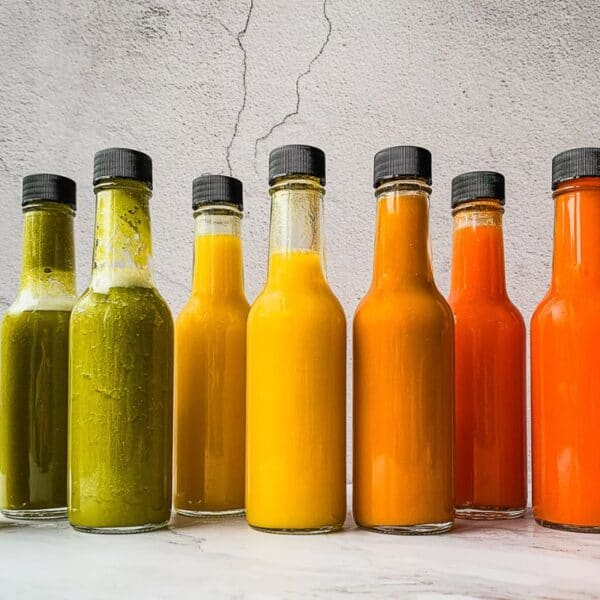
Equipment
- Fermentation weights and Lids – Optional but recommended
- ¾ Quart (750ml) Mason Jar
Ingredients
- 2 cups Filtered or spring water – 480ml
- 1 tbsp Kosher or pickling salt – 17 grams
- 1 pound Hot and sweet peppers – Chopped roughly, about 3-4 cups. You may need to use more or less to fill the jar you choose for your fermentation
- 1-2 Garlic cloves
- ½ Onion – peeled and kept halved
After Fermentation is Complete
- 1-2 tbsp White distilled vinegar – 15-30ml (Optional)
Instructions
- Make Brine. In a Pyrex glass measuring cup, combine 2 cups Filtered or spring water and 1 tbsp Kosher or pickling salt. Wisk to combine. The salt should be completely dissolved before proceeding.
- Pack jar. Add one clove of garlic and the white onion half to the bottom of a mason jar. Carefully pack peppers into the jar, pressing down firmly as you fill it. Apply fermenting weight, if using.
- Add Brine. Pour the salt brine into the mason jar and cover the peppers. Tap the jar a few times to release any air bubbles. Make sure all the peppers are covered in liquid. Discard any leftover brine.
- Ferment. Apply the fermenting lid. Ferment on the counter for 3–5 days. The longer you ferment, the tangier the sauce will be. The brine may get cloudy, and that’s completely normal.
- Strain and Blend. Strain the contents of the mason jar in a sieve over a bowl, reserving the brine. Add the peppers, onions, and garlic to a blender with a splash of the brine. Blend on high until homogenous (1–2 minutes). Add the optional white vinegar and blend again for 30 seconds. Taste and adjust seasoning. If the sauce is too thick, add more brine and blend again on high speed for 30 seconds.
- Bottle. Transfer the hot sauce to clean hot sauce bottles or mason jars and refrigerate for up to 6 months.
Video
Notes
Nutrition
Nutrition information is automatically calculated, so should only be used as an approximation.
 Like this recipe? Rate & comment below!
Like this recipe? Rate & comment below!
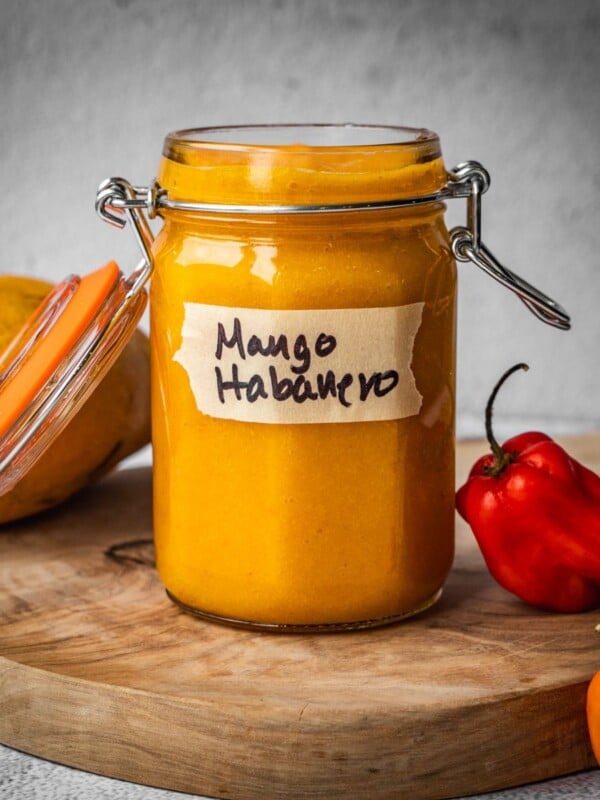
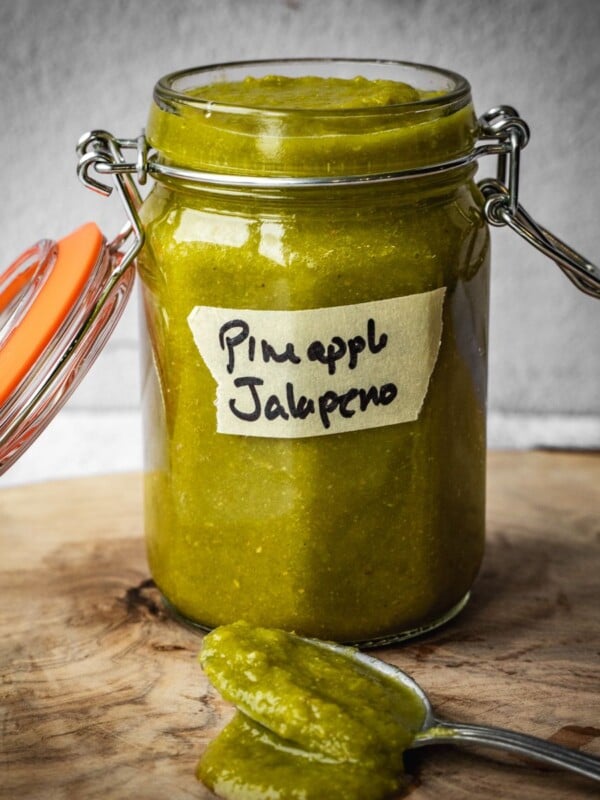
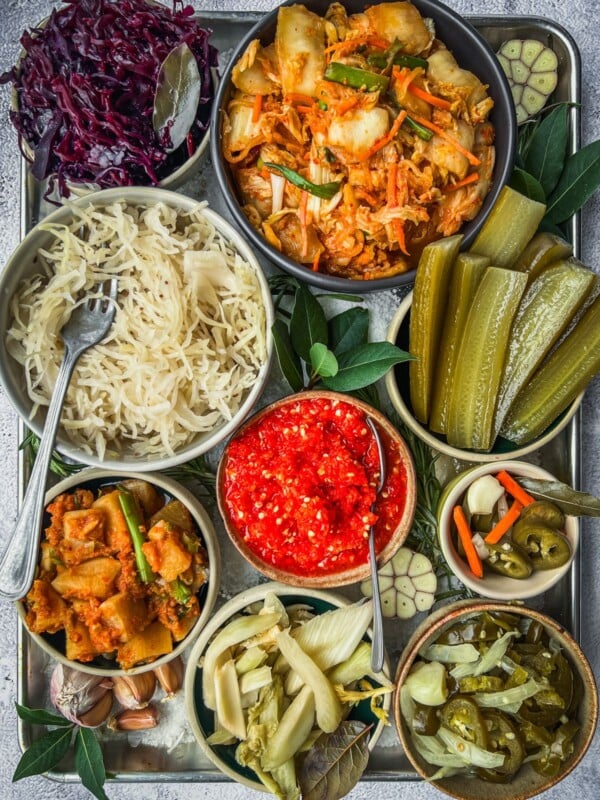
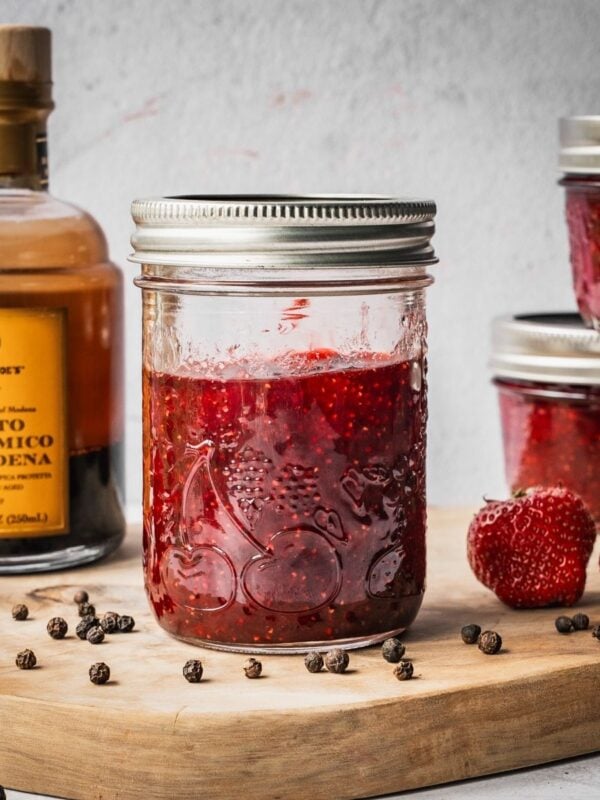
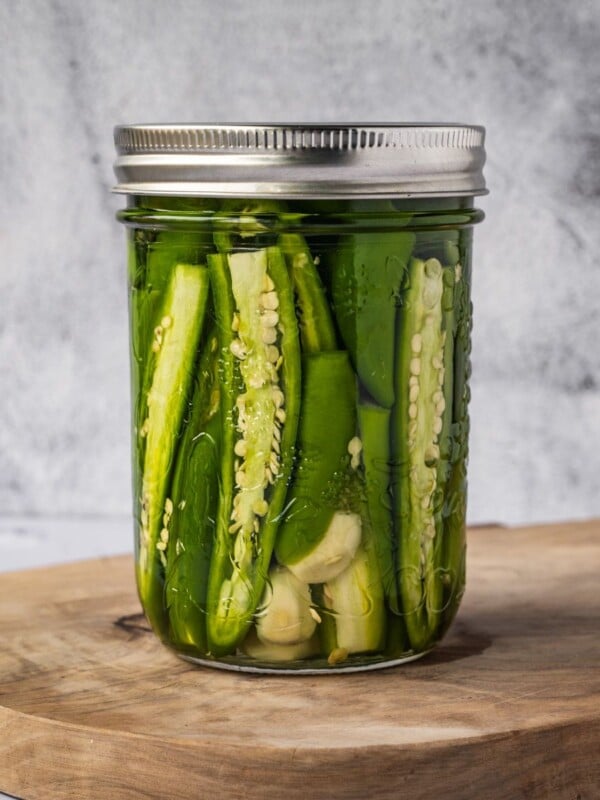
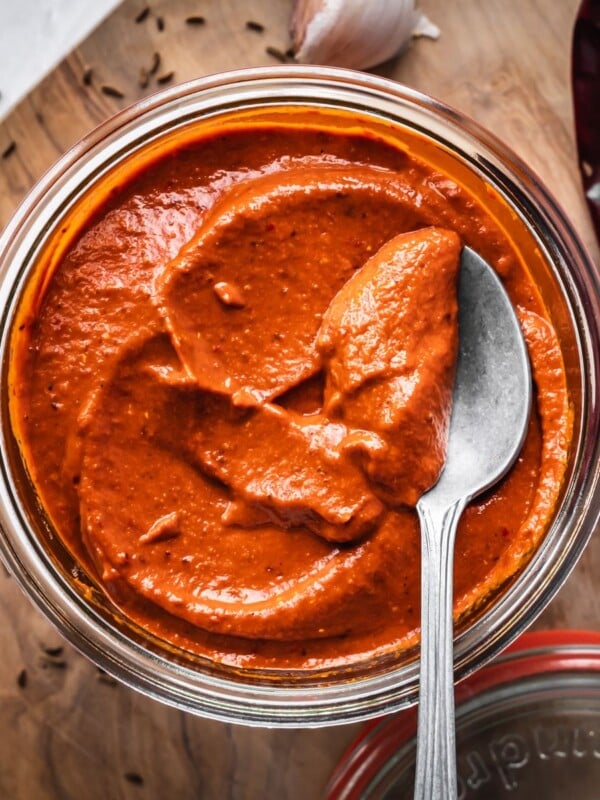









So is waterbathing this not recommended? What would make my hot sauce shelf stable?
This recipe was not developed with that in mind. The sauce is meant to be refrigerated.
I have been putting Chillies in the freezer as they come in, could I use these
You can but I would recommend adding a couple of fresh chilies or half a bell pepper to each jar if you are using frozen chilies. Freezing kills off a lot of the microbes. So if you use just frozen vegetables the ferment will likely be slow to start which could cause issues. Adding a small amount of fresh vegetables will provide a much larger initial colony of lactobacillus to get the ferment going.
Hi, can I use hot peppers that are not rippen?
Yes, it will be a green hot sauce in this case.
About how much does this make? Curious how many jars I’ll need for storage.
It depends on how much pepper you ferment, how much you decide to dilute the finished product with brine, if you decide to strain the final sauce, and the size of your bottles. I can’t really say exactly how many jars you’ll need. But with a pound of peppers, you should end up with 2 or 3 small 4-oz hot sauce bottles.
Can you can this for long term storage?
No, this recipe is meant for the fridge. You will find that fermented foods are meant to be refrigerated. If you can them all the good probiotics will die off.
I was hoping to use lemon chillies. What do you think? Do I reseed the chillies?
You can use any fresh peppers (hot or mild) you like. Just make sure you are blending complementary colors together. Yellow chiles blend nicely with orange, red and green peppers.
Can you do a secondary ferment after the initial 3-5 days (after everything is processed). I’m gonna give it a try….to mellow the heat a little.
Yes, you can ferment for longer. But if you plan to process and ferment again, don’t add the vinegar (if using) until you’re completely happy with the ferment.